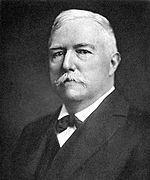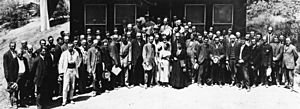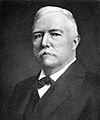Edward Emerson Barnard facts for kids
Quick facts for kids
Edward Emerson Barnard
|
|
|---|---|
 |
|
| Born | December 16, 1857 |
| Died | February 6, 1923 (aged 65) |
| Nationality | American |
| Known for |
|
| Awards |
|
| Scientific career | |
| Fields | Astronomy |
| Signature | |
Edward Emerson Barnard (born December 16, 1857 – died February 6, 1923) was a famous American astronomer. He was often called E. E. Barnard. People knew him as a very talented astronomer who was great at observing the sky. He is most famous for finding out in 1916 that a star, now called Barnard's Star, moves very fast across the sky. This star is named after him.
Contents
Edward Barnard's Early Life
Barnard was born in Nashville, Tennessee. His father died before he was born, so he grew up in a poor family. He did not get much formal schooling. When he was nine, he started working as a photographer's helper. This was his first interest.
Later, he became very interested in astronomy. In 1876, he bought a 5-inch refractor telescope. This type of telescope uses lenses to make things look bigger. In 1881, he found his first comet, but he didn't tell anyone about it. He found two more comets later that same year and in 1882.
While still working as a photographer, he married Rhoda Calvert in 1881. In the 1880s, a man named Hulbert Harrington Warner offered $200 for each new comet discovered. Barnard found five comets and used the money to build a house for his wife and himself.
Amateur astronomers in Nashville heard about him. They collected enough money to give Barnard a special study opportunity at Vanderbilt University. He never officially graduated, but the university gave him an honorary degree. In 1887, he joined the staff at the Lick Observatory. However, he had some disagreements with the director there.
Discoveries in Astronomy

In 1889, Barnard watched the moon Iapetus pass behind Saturn's rings. He saw a shadow move across the moon as it passed through the gap between Saturn's inner rings and the planet. He didn't know it then, but he had found proof of the "spokes" of Saturn. These are dark shadows that go straight across the rings. At first, people doubted these spokes, but the Voyager 1 spacecraft later confirmed them.
In 1892, he observed a nova, which is a star that suddenly becomes very bright. He was the first to see that it was giving off gas. This helped him figure out that it was a huge stellar explosion. In the same year, he also found Amalthea, the fifth moon of Jupiter. He was the first person to discover a new moon of Jupiter since Galileo Galilei in 1609. This was the last moon found by just looking through a telescope, not by using photos.
In 1895, he became a professor of astronomy at the University of Chicago. There, he could use the 40-inch telescope at Yerkes Observatory. He spent a lot of time taking photographs of the Milky Way galaxy. He and another astronomer, Max Wolf, discovered that some dark areas in the galaxy were actually clouds of gas and dust. These clouds blocked the light from stars behind them. From 1905, his niece, Mary R. Calvert, worked as his assistant.
The faint Barnard's Star is named after Edward Barnard. He discovered in 1916 that it moved very quickly across the sky compared to other stars. This star system is the second closest to our Sun, after the Alpha Centauri system.
Barnard was also a pioneer in astrophotography, which is taking pictures of space. His Barnard Catalogue lists many dark nebulae, which are clouds of gas and dust that block starlight. These are called Barnard objects and have numbers from Barnard 1 to Barnard 370. He published his first list in 1919.
He passed away on February 6, 1923, in Williams Bay, Wisconsin. He was buried in Nashville. After he died, many of his amazing space photographs were published in 1927. This book was called A Photographic Atlas of Selected Regions of the Milky Way. His niece, Mary R. Calvert, and Edwin B. Frost helped finish this work.
Comets Discovered by Barnard
Between 1881 and 1892, Edward Barnard discovered 15 comets. Three of these comets were periodic, meaning they return regularly. He also helped discover two others:
- C/1881 (He didn't announce this one)
- C/1881 S1
- C/1882 R2
- D/1884 O1 (Barnard 1)
- C/1885 N1
- C/1885 X2
- C/1886 T1 Barnard-Hartwig
- C/1887 B3
- C/1887 D1
- C/1887 J1
- C/1888 U1
- C/1888 R1
- C/1889 G1
- 177P/Barnard (P/1889 M1, P/2006 M3, Barnard 2)
- C/1891 F1 Barnard-Denning
- C/1891 T1
- D/1892 T1 (Barnard 3) – This was the first comet ever found using photography! It was seen again in 2008.
Honors and Things Named After Him
Awards
- Associate Fellow of the American Academy of Arts and Sciences (1892)
- Lalande Prize (1892)
- Gold Medal of the Royal Astronomical Society (1897)
- Member of the American Philosophical Society (1903)
- Prix Jules Janssen, a top award from the French astronomical society (1906)
- Bruce Medal (1917)
Things Named After Edward Barnard
- Barnard (lunar crater) – A crater on the Moon
- Barnard (crater on Mars) – A crater on Mars
- Barnard Regio on Ganymede – A region on Jupiter's moon Ganymede
- Asteroid 819 Barnardiana
- NGC 6822 – A galaxy also known as Barnard's Galaxy
- Barnard's Loop – A large nebula in the constellation Orion
- Barnard's Star – A famous star known for its fast movement
- Barnard Hall – A building at Vanderbilt University
- Barnard Astronomical Society – An astronomy club in Chattanooga
- Mount Barnard – A mountain in California
- A baggage car on the Central Railroad of New Jersey's "Blue Comet" train was named after "Barnard."
See also
 In Spanish: Edward Emerson Barnard para niños
In Spanish: Edward Emerson Barnard para niños
- Barnard 33 (The Horsehead Nebula)
- Barnard 68
- John Byrne
- California Nebula
- Category:Barnard objects
- Category:Discoveries by Edward Emerson Barnard
Images for kids


